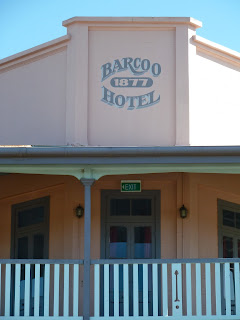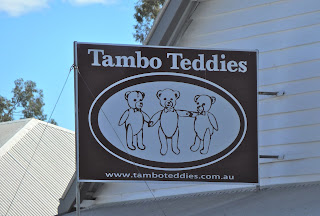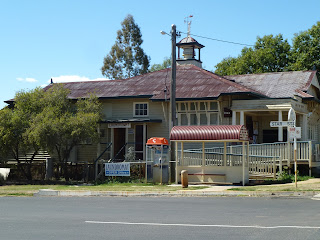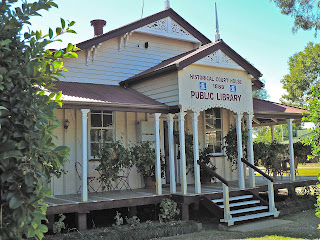The morning after Clancy's horror show (see Outback 3 Outlaw country), our journey to Blackall seemed to prolong the disappointment of the Isisford experience. The Barcoo was dry-as-a-bone, of course; it was harder than usual to frame an interesting picture in the saleyards, where we stopped for breakfast; and the roadside bush only thinly veiled wanton land-clearing beyond. The landscape with its tree debris was desolate. There were many roos, with the accompanying carnage. And this was the last proper day of our Outback journey: I don't do end-of-the-holidays terribly well.
Blackall restored the faith, however. Its history is all about wool: sheep and wool. At one end of town is Ram Park Historical Village, where you can wander through historic buildings and imagine yourself back in time. At the other end of Shamrock Street is a statue of Jack Howe, the town's most famous son and perhaps Australia's most famous shearer. On 10 October 1892, Jack hand-sheared 321 sheep in 7 hours and 40 minutes, a record that still stands. His success was attributed to his great physical strength, sturdy build and large hands.
We wandered up and down Shamrock Street, finding interesting things.
I was thrilled to see a local paper surviving in Blackall. An independent providing an alternative to the Murdoch megalopoly is great news, and it's good for small or remote communities to have their own voice, not that of urbanized Oz. Unfortunately, a month after we bought our copy, I read on the ABC* that The Barcoo Independent may not survive beyond the end of this year because of a fall in advertising revenue. The paper has reported Blackall's news off and on for more than 120 years.
In the saddlery we found Chase, from Wyoming. He was looking after the place and was keen to chat, being an affable chap. We discussed what had brought us to Blackall. In the US, Chase had been in the artificial insemination (of cattle) business, which is why he came to Australia originally. When we took our leave, he shook our hands as if we'd known him for years.
There were bottle trees and those funny stuffed figures that are not as uncommon as you might expect in remote parts.
And there was the Black Stump. The original stump was used by 19th-century surveyors mapping Queensland: it provided a stable base for large theodolites. The original stump was eventually destroyed by fire, and has been replaced with a petrified alternative. The expression 'beyond the black stump' came to mean beyond civilisation, rather like 'back o' Bourke', I suppose. Blackall is not the only remote town to claim the original Stump of the saying, however.
The Woolscour is Blackall's pièce de résistance. This was where wool was cleaned of dirt and sheep's natural oil (lanolin). Clean wool weighed less for transporting and fetched a higher price in Europe. Detergent added to the hot artesian water effectively scoured the wool and made it soft. Many Western Queensland towns had scours – Charleville, Winton, Longreach, Barcaldine, Julia Creek. Blackall's was built in 1908 and operated by steam-driven machinery from England. The wool industry was booming then, the Australian economy was stable, and rural towns were expected to grow. The opening of the scour coincided with the railway's arrival from the east coast, via Jericho. At peak production, following World War 1, there were two shifts of 12 men producing 150 bales a day. By the wool boom of mid-century, buyers weren't fussy about wool being clean or greasy. Blackall's scour closed in 1978, the last in Queensland to do so.
Shearing was an integral part of the Woolscour operation, but there wasn't a sheep to be seen on our visit. In fact, they seemed to have been replaced. My friend spotted a new parrot.
 |
| Red-winged Parrot |
At Blackall we joined the Landsborough (Matilda) Highway, heading south for Mitchell (on the Warrego Highway) and then back east. There wasn't much to write home about between Blackall and Tambo. I was driving; my friend was sleeping, and the country wasn't really Outbacky any more. I believe the more you travel into remote regions, the further west (from the east coast) your criteria for Outback begin. This may look Outbacky to many people, but each to her own parameters.
Next up was Tambo. The town was first settled in the 1860s and has colonial-style buildings to prove it. Settlers were attracted to the region's rich black soils; and drovers used to make stopovers here. Cattle and sheep are still important. Teddies didn't appear on the scene until three women in the early 1990s came up with a novel idea to stimulate the town's flagging economy: making teddies from sheep wool. More than a few people thought it was a bizarre idea, but 20-odd years later, tourists flock to buy a Tambo Teddy, and the business employs at least a dozen people. In 2013, three different women bought the company with the intention of expanding the teddies' international market.
Further down the Landsborough there had been more tree clearing. Felled trees are a depressing sight.
Augathella seemed to offer a strange choice for the tourist, but we didn't have time to investigate. We continued to Morven.
Meat Ants, by the way, are found all over Australia, not just around Augthella, QLD. Also known as Gravel Ants, they live in sandy or gravelly soils in forests or heathlands, and build large nests underground, often covered with gravel or small pebbles and forming a mound. The ants are territorial and can be quite aggressive if they're disturbed. The Australian Museum describes farmers placing animal carcasses over Meat Ants' nests to dispose of them – well, all but the bones.
Our last holiday treat was a visit to Tregole National Park, 11 kilometres south of Morven, where we were to join the Warrego Highway. If I hadn't been on the Park mission, I would have wanted to turn right for Charleville and begin another Outback trip. I had read about stands of Ooline trees, a species listed as Vulnerable as a result of land clearing. It's unusual to find them here, in a semi-arid region where the Brigalow Belt meets the Mulga Lands: they originated in the rainforests of the Pleistocene Era, 10,000 years ago. The Ooline, or Scrub Myrtle, is a medium to large tree with bright green leaves and rough bark. There's a walking circuit through the National Park, along a ridge and back, and a numbering system that allows you to identify trees. It's an easy walk of just over two kilometres, which takes about an hour if you're like us and stop a lot. We surprised late-afternoon roos among the trees; but we saw no one.
My friend found a small hole and decided to bother some ants. He stamped hard, bringing them scuttling to the surface. Numerous times. I'd have been annoyed.
We thoroughly enjoyed our last walk through the forest, and dallied a bit too long. The shadows were lengthening and we had 100 kilometres still to drive.
The sun was directly behind us as we hit the Warrego. Thankfully, there was little roadkill and therefore, we hoped, few roos. The woodland was fairly open and set back from the road, but it closed in as the light faded, and we had to slow right down. Which enabled us to spot a wheel on the opposite verge by an old Land Rover. It was a sign, we concluded, and as soon as we could we turned and returned. Owen Murphy was a local farmer who had a flat tyre – and a flat spare – and a bad knee. He'd been sitting there for an hour and a half, with four dogs, and no one had stopped until we did. Before this trip, we'd taken the back seats out of our car. But my friend rearranged the clobber in the back and cleared a space on the floor for me to sit, while Owen got in the front with his bags. He'd tethered his dogs to the nearside of his car, but I was concerned. It was on a bend, and road trains were frequently passing by. We couldn't fit four dogs in with us, however, and it was unlikely they could have stayed in the motel room he would have to find for the night in Mitchell.
Owen chatted as we drove the last dozen miles or so into town. He told us about roo-proof fences; how there were fewer roos around lately; and how people just didn't stop and help those in trouble like they used to. I was sorry to hear this: it's an Australian trait we've come to associate with Outback travel; a commendable characteristic that reduces the worry of getting into difficulty. We dropped him in town where he directed us.
Our Mitchell motel was pleasant enough. We ate in a lively bar where a bunch of laughing ladies were having supper together.
Next morning, Mitchell had nothing to keep us, and we left at 07:30. It's 563 kilometres from Mitchell to Brisbane. We'd decided that there would be no detours or stop-offs, but straight back home along the most direct route. Breakfast in Roma tourist information centre: croissants, buttered and jammed and cut up for us – but not hot, yay! A driver change in Miles at 10:25; Chinchilla by 11:00. A great welcome back into Southeast Queensland, being flashed down by an unmarked cop car near Dalby, or so we thought, but it was the motorbike in front of us they were after. Lunch in Warra, by a pretty little station on the coal line. A brown snake writhing on the highway; and the first serious cloud in at least two weeks, 195 km from the city.
We were back in Brissie by our target time of 17:00; 22 days and more than 8600 kilometres later; almost definitely the best trip ever. I would do it all again at the drop of a hat.
This post was last edited on 29 November 2015































































No comments:
Post a Comment